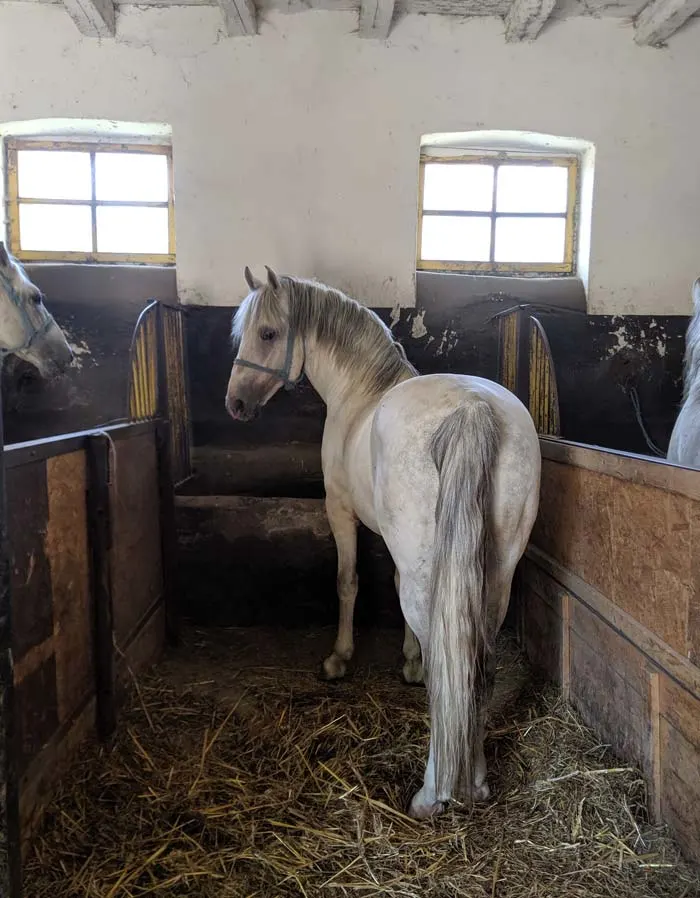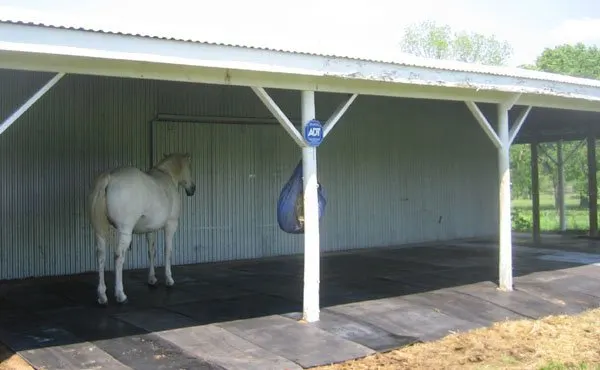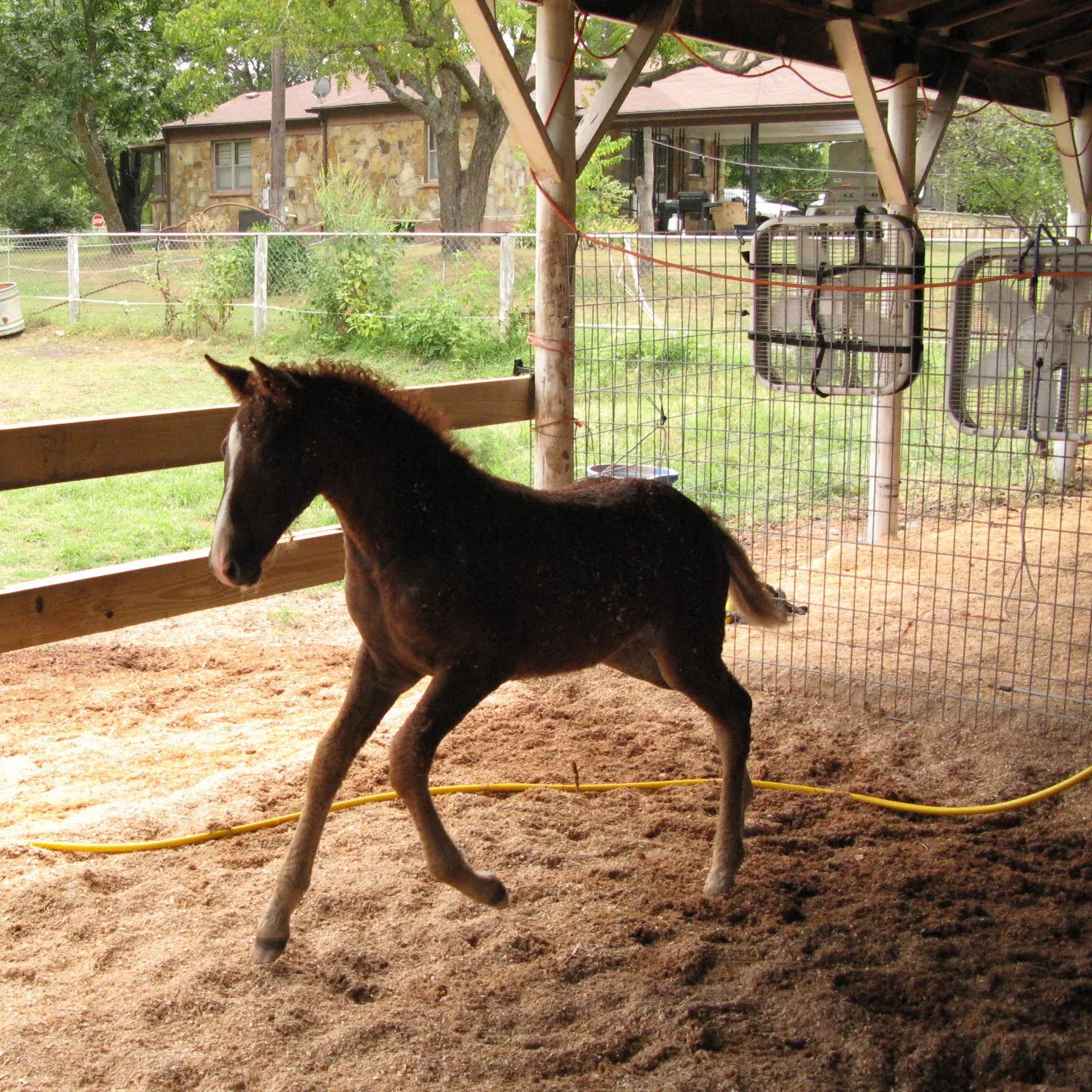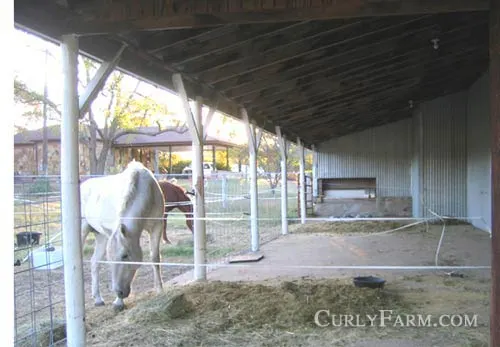Safe stalls are key to basic horse keeping. Before we can finish chores, tack up, and ride our horse, we’ve got to have a safe, secure place for them to live.
The problem? Horse stalls are expensive. Prefab horse stalls cost between $1,000 to $5,000!
Even homemade stalls using traditional stall construction plans are expensive. With lumber here in the Northwest near all-time highs, building a horse stall with 2×4’s isn’t much cheaper than metal, prefabricated stalls.
But luckily, there are inexpensive homemade horse stall options. With some creativity and a DIY spirit, you can create safe horse stalls using inexpensive materials that won’t hurt your wallet. 💸
HINT: to keep costs low, check if you have a tool library near you. Tool libraries offer the ability to borrow from a huge variety of tools for a low annual cost, making it possible to take on big projects for much less.
In this article, I’ll break down the best practices for building cheap, homemade horse stalls and I’ll share four specific inexpensive horse stall ideas that are both effective and low-cost. 🐴💡
Best Practices for Horse Stalls
Before approaching any DIY horse stall projects, it’s important to understand the basics. Knowing what a good horse stall is can help you adapt your project to budget.
[These best practices were compiled with single-horse stalls in mind, which is generally the standard. For information about shared stalls, you can check out my article about stabling horses in communal stalls. ]
8 Essentials for Building Safe Horse Stalls
- Sufficient Stall Size📏: The size of the stall should be big enough to allow the horse to move comfortably and lie down comfortably. A standard stall size recommendation for an average-size horse is a minimum size of 12 feet x 12 feet. Size recommendations may change based on your horse’s breed and size.
- Smooth, Easy to Clean Flooring 🧱: The flooring should be non-slip and provide good drainage. Concrete or compacted gravel covered with rubber mats is common, as it is easy to clean and provides traction. Avoid using bare concrete, as it can be hard on a horse’s joints.1
- Ventilation 💨: Don’t neglect good ventilation. A recent Swedish study found that horses kept in stalls have more respiratory issues that horses that live outdoors all the time.2 Airflow helps to control moisture levels, reduce odors, control flies, and prevent respiratory issues. Windows, vents, or an open design at the top of the stall can help facilitate proper airflow.
- Water Source 💧: A clean and easily accessible water source is crucial to keep horses healthy and avoid colic. Install a water bucket or automatic waterer in a corner of the stall, away from feed and bedding.
- Feeding Area 🍎: Every stall should have a space within the stall for feeding the horse. With good individual stalls, you can get rid of feed bags and finish your horse chores faster. This area can be equipped with a hay rack or feeder, allowing the horse to eat comfortably without mixing hay with bedding.
- Durable Construction 🦺: Horses are much, much larger and stronger than humans. When you’ve planning your inexpensive horse stalls, don’t cut corners on quality materials and heavy-duty hardware. Ensure there are no sharp edges, protruding nails, or other potential hazards within the stall that could cause injury to the horse.
Types of Horse Stalls
You might be surprised to learn that there are several types of horse stalls. Usually, when we talk about horse stalls, we mean “box stalls.” Here’s a list of the most common type of horse stalls, and their average cost:
Box Stalls:
💲 Average cost to build: $1,500 to $5,000 per box stall

A box stall is a type of horse stall that usually measures the size of a human bedroom – about 12×12. These stalls provide ample room for a horse to move around freely. It typically has solid walls on three sides, with a gate or door on the fourth side. Box stalls allow for natural behaviors like lying down and rolling. Horses that live in box stalls have less stress hormones, according to researchers, than horses that live in tie stalls.3 Box stalls are commonly used in boarding facilities, training barns, and private horse stables to provide horses with a comfortable and secure living space.
| Box Stall Pros | Box Stall Cons |
|---|---|
| Ample space for freedom of movement 🐎 | More expensive to build and maintain 💰 |
| Allows natural behaviors 🌾 | |
| Offers comfort 🛏️ | Requires more cleaning effort ⏰ |
Cost to Build A Box Stall
The cost of constructing a box stall can vary dramatically depending on whether you use prefabricated stall panels or build using low-grade lumber. On average, you can expect to spend anywhere from $1,500 to $5,000 per box stall. This includes materials like lumber, hardware, and stall mats.
Tie Stalls:
💲 Average cost to build: $500 to $2,000 per stall

A tie stall is typically designed as a narrow rectangle, constructed with sturdy materials such as wood or metal. It usually consists of two solid walls and a bar, where the horse is tied. The stall may also have a solid partition between adjacent stalls to provide separation between horses. Generally, modern horse welfare dictates that horses should not be left overnight in tie stalls. Researchers have found evidence that horses kept in tie stalls have higher stress hormones and poorer health.4
| Pros | Cons |
|---|---|
| Efficient use of space 📐 | Limits movement ⛓️ |
| Suitable for short-term tasks 🚿 | Less comfort for the horse 😕 |
| Provides control 🔒 | Potential safety concerns ⚠️ |
Cost to Build A Tie Stall
Tie stalls are typically less expensive to build compared to box stalls since they require less space and fewer materials. On average, the cost of constructing a tie stall can range from $500 to $2,000 per stall. This estimate covers the cost of materials like lumber, hardware for the tie point, and installation.
Pasture Stalls or Run-In Shelter:
💲 Average cost to build: $1,000 and $5,000

A pasture stall, also known as a run-in shed or field shelter, is an open-sided structure placed in a pasture or outdoor area. It provides horses with shelter from the elements while allowing them the freedom to move in and out as they please. A typical pasture stall has a roof to protect against rain and sun, and it may have one or more solid walls for added wind protection.
| Pros | Cons |
|---|---|
| Constant access to shelter 🏡 | Less protection from extreme weather 🌧️ |
| Promotes natural grazing 🌿 | Some horses may not sleep well, affecting performance5 🥱 |
| Allows freedom of movement 🏇 | Requires ample space and fencing 🌳 |
Cost to Build A Pasture Stall/Shelter:
The cost of building a pasture stall, such as a run-in shed or field shelter, can vary depending on its size, the materials used, and additional features like walls or flooring. On average, you can expect to spend between $1,000 and $5,000 for a basic pasture stall. However, larger or more elaborate designs can cost upwards of $10,000 or more. The cost estimate includes materials such as lumber, roofing, and labor expenses.
Four Cheap Horse Stall Ideas
Keeping the best practices I’ve outlined in mind, let’s consider how to build our own cheap horse stalls! I’ve gathered four different approaches that might work for you.

💡 Idea 1: Welded Wire Fence Panels Secured to Wood Posts
The first option in our list of cheap horse stall ideas is using welded wire fence panels secured to sturdy wood posts. This cost-effective and practical solution provides a safe and secure space for your horse. 🛠️
Start by mapping out the stall’s dimensions and mark the spots where the wood posts will go. Dig holes for the posts, ensuring they’re deep enough to provide proper support. Once the posts are in place, attach the wire fence panels securely using sturdy fasteners such as screws or nails.
As you assemble the panels, pay close attention to the tension of the wire, ensuring it is taut and free from any sagging. This will prevent your horse from potentially getting tangled or injured. Take your time to reinforce any weak points and ensure the overall structure is sturdy and secure.
Lastly, pay attention to the stall floor. Consider adding rubber mats or bedding material on the floor for added comfort. Install a feeding trough and water bucket and make sure they are securely fastened to prevent spills.


💡 Idea 2: Recycled Pallets – An Eco-Friendly Solution!
When it comes to building horse stalls with recycled pallets, you’re embracing a cost-effective and eco-friendly solution.♻️ Pallets are frequently discarded by local businesses, making them easily accessible and budget-friendly. By repurposing pallets, you can create functional and affordable partitions for your horses.
However, it’s crucial to prioritize safety throughout the construction process.
- Before using any pallets, thoroughly inspect them for any protruding nails, loose boards, or sharp edges that could pose a risk to your horse’s well-being. Smooth out any rough spots or splinters to ensure a safe environment for your equine friend.
- Make sure that the wood used in the pallets is untreated. Treated wood often contains chemicals that can be harmful to horses if ingested or in prolonged contact. By using untreated pallets, you avoid potential toxins and ensure the well-being of your horse.
- Once you have gathered your pallets and ensured their safety, you can begin constructing your horse stalls. Start by designing a layout that suits your space and horse’s needs. Secure the pallets together using sturdy screws or nails, ensuring they form a stable structure. Depending on the desired height, you can stack pallets vertically or horizontally, securing them firmly to create walls.
- To add stability, consider reinforcing the corners and joints with additional lumber or brackets. You can also use electric fencing to make sure that horses don’t lean on the pallet walls.
While pallets can provide an excellent framework for your horse stalls, you’ll need to consider additional materials for flooring and other stall elements. Youll need stable beams or posts to attach the stall walls to.
By combining creativity with a focus on safety, building horse stalls with pallets allows you to create an economical and environmentally friendly space for your horses. Just remember to continually monitor the condition of the pallets, make any necessary repairs, and provide regular maintenance to ensure the long-lasting safety and comfort of your equine companions.
💡 Idea 3: Reinforced PVC Pipe Enclosures – Light and Versatile!
The third gem among our cheap horse stall ideas is the innovative use of reinforced PVC pipe enclosures. These are not just affordable and lightweight, but can be easily adapted and resized as needed.
PVC, however, is not recommended for long term use, with horses that challenge fencing, or in cold climates. Shattered PVC pipe can have extremely sharp edges and potentially cause serious injury to horses.
PVC pipes can be interconnected using purpose-made fittings and then further reinforced with wooden planks for enhanced stability. It’s an effective way to build an inexpensive horse stall.
In Review:
Creating safe and inexpensive horse stalls doesn’t have to break the bank! By following the best practices outlined in this article and exploring these four cheap horse stall ideas, you can provide a secure environment for your horse while saving money. 🐴💰
Remember to prioritize safety by inspecting materials for potential hazards and ensuring your horse’s well-being at all times.
By getting creative and putting in some effort, you can build affordable horse stalls that not only meet your budget but also provide a comfortable and secure space for your horses. So go ahead, get your tools out and begin work building a fantastic home for your equine companions! 🐴🛠️💰
- Pardoe, C. H., McGuigan, M. P., Rogers, K. M., Rowe, L. L., & Wilson, A. M. (2001). The effect of shoe material on the kinetics and kinematics of foot slip at impact on concrete. Equine Veterinary Journal, 33(S33), 70-73. [↩]
- Yngvesson, J., Rey Torres, J., Lindholm, J., Pättiniemi, A., Andersson, P., & Sassner, H. (2019). Health and Body Conditions of Riding School Horses Housed in Groups or Kept in Conventional Tie-Stall/Box Housing. Animals, 9(3), 73. https://doi.org/10.3390/ani9030073 [↩]
- Hoffmann, G., Wagels, E., Kraeft, S., Goossens, L., Ammon, C., Georg, H., & Feige, K. (2012). Comparative study of horses in tie stalls, individual housing in boxes and group housing. Pferdeheilkunde, 28(6), 702-710. [↩]
- Hoffmann, G., Wagels, E., Kraeft, S., Goossens, L., Ammon, C., Georg, H., & Feige, K. (2012). Comparative study of horses in tie stalls, individual housing in boxes and group housing. Pferdeheilkunde, 28(6), 702-710. [↩]
- Harewood, E. J., & McGowan, C. M. (2005). Behavioral and physiological responses to stabling in naive horses. Journal of Equine Veterinary Science, 25(4), 164-170. [↩]
